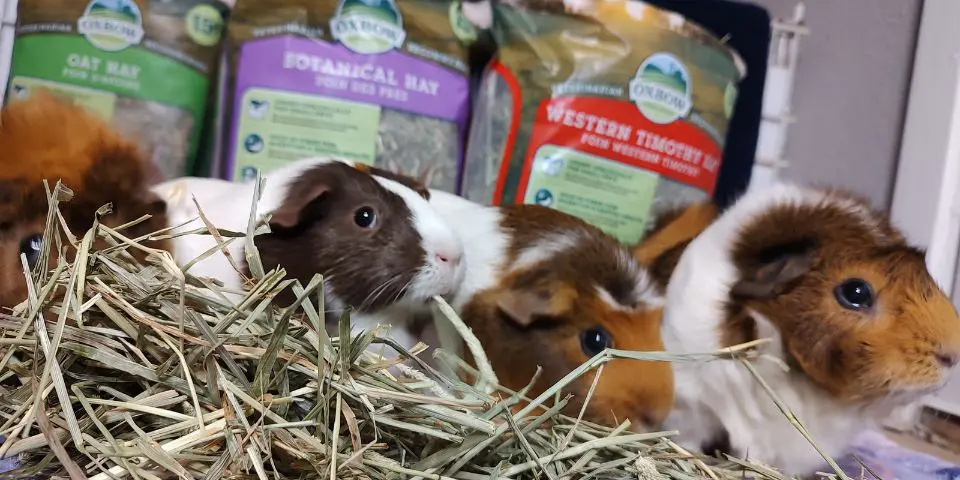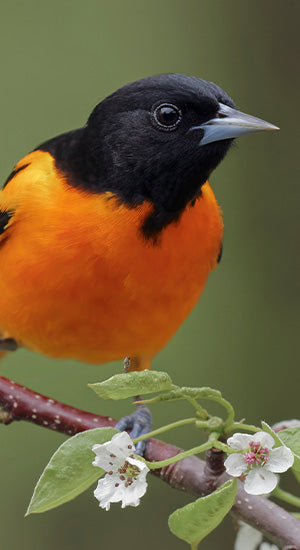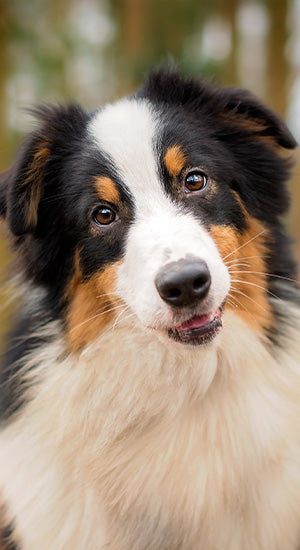What Are The Best Types Of Hay For Guinea Pigs?

Why Is Hay Important For Guinea Pigs?
Small herbivorous mammals such as guinea pigs are avid eaters! High-fiber diets are especially important for guinea pigs, as they have GI systems that require constant fibrous input in the form of plant material. While it may come as a surprise to new guinea pig pet parents, grass hays can and should be offered in unlimited amounts to their small herbivore for this reason. Frequently offering your guinea pig a grass hay throughout the day keeps them interested in eating and consistently provides an available material to eat, keeping their GI system moving at a healthy pace.
While the wild ancestors of guinea pigs often had to juggle finding enough to eat with hiding from predators, when they’re safe indoors our small companions no longer need to juggle the stress of eating as much calorically dense food as possible while avoiding becoming a meal for another animal. This is another reason why grass hays are the basis for small herbivore diets: it keeps their GI systems functioning while not being too calorically dense to cause major weight gain.

In addition to hay’s nutritional significance, grass hay plays a major role in keeping small herbivores’ dentition (teeth) healthy. Our small herbivores have teeth that have evolved to handle the constant chewing motion of eating fibrous plant material. This means that your guinea pig’s teeth constantly grow as a way to compensate for the heavy wear their dentition experiences while eating the large amounts of food they need. In this sense, hay is important to provide because it can help prevent your pet’s teeth from overgrowing and causing serious issues like tongue entrapment or malocclusion.
Now that we know about the importance of hay in your guinea pig’s diet, let’s answer: what is the best hay for your guinea pig? There are short and long answers here!

Western Timothy Hay
Many pet parents of small herbivores know about Western Timothy Hay, but for those who may not, Western Timothy Hay is considered the “staple” grass hay for small herbivores like guinea pigs, rabbits, and chinchillas. This type of hay is an optimal high-in-fiber forage.
What makes Western Timothy Hay so ideal for adult guinea pigs in particular is that it is a grass hay. Grass hays do not contain excess amounts of calories or energy in comparison to legume hays like alfalfa, so it can be provided in the ample amounts necessary for keeping our little ones’ GI systems healthy. Many pets particularly enjoy that Western Timothy Hay contains the perfect balance of stems, leaves, and seed heads, creating a fun variety while still being nutritionally correct for adult small herbivores.

Orchard Grass
Orchard Grass, similar to Western Timothy Hay, can be considered another type of hay that guinea pigs can consume unlimited amounts of each day. Some pet parents find that their guinea pig may prefer orchard grass if their little one is especially particular to eating the leafy parts of hay, leaving the seed heads or stems behind.
If your guinea pig loves to relax within or on top of a pile of hay, orchard grass may also be a winner. With a bag of orchard grass tending to have a more soft texture than Western Timothy Hay, some pets may find it especially enticing for relaxing!
Orchard Grass not only benefits pets. Some pet parents who have a hay allergy find that they have a less severe reaction to Orchard Grass than they do to Western Timothy Hay when handling these respective forages. If you have a known allergy to Western Timothy Hay, it may be time to try Orchard Grass. However, if you are known to have severe reactions such as hives or throat tightness to many materials, always discuss trying knew forages with your doctor first!
If you have known allergies but they can be managed, make sure to read our tips toward the bottom of this blog on limiting your allergic reaction to your pet’s food.
Hay Blends
Hay Blends is simply the best of both worlds! Consisting of a 50% / 50% blend of Western Timothy Hay and Orchard Grass, this hay can serve as either a great daily forage, or as a great transition hay if you’re moving your pet from Western Timothy Hay to Orchard Grass (or vice versa). If you find your pet is getting pickier with their daily forage, trying this hay may help them snap out of their picky behavior.

Botanical Hay
Oxbow’s Botanical Hay is essentially Western Timothy Hay with a twist! While it consists mostly of our favorite high-fiber forage, it also contains wonderful, safe-to-eat aromatics like chamomile, lavender, clover, and lemon balm. Pet parents love to keep a bag or two of this type of hay in their enrichment and first aid arsenals.
While it can be a fun hay to provide as a yummy surprise, it can also be kept on-hand in case your pet ever exhibits signs of pickiness or boredom with their regular hay. If your pet is leaving more and more hay behind by the time they start begging for a new pile of hay, now might be the time to change things up. You can either provide a pile of Botanical Hay alone, or you can mix Botanical Hay in with the remaining clean, unsoiled hay in their habitat to encourage them to eat more of what they’re considering no longer good.
Botanical hay can also be a useful hay to keep in a first aid kit, as the aromatics may help entice a little one who is not feeling well to eat on their own. If your guinea pig is not eating anything on their own, please contact your veterinarian right away, as this is a symptom of a painful condition called Gastrointestinal Stasis.
Alfalfa Hay
Alfalfa hay is what we call a legume hay and is a member of the sweet pea family. Unlike the four hays mentioned above, alfalfa is more calorically dense in comparison. It can provide the additional nutrition and energy necessary to guinea pigs that are in the infant and young (0 – 6months old) life stages, as well as to pregnant or nursing mothers.
For nursing, pregnant, or young guinea pigs, alfalfa hay can be mixed in with Western Timothy Hay or Orchard Grass, and even at some points in the day provided as the sole form of forage.
As a general rule, adult guinea pigs that are not nursing or pregnant should not be given this hay in regular large quantities, but it makes a great treat when offered in small amounts.
Alfalfa can also be beneficial for senior guinea pigs who may be losing weight or may need an appetite stimulant. For this reason, some pet parents keep it in their first aid kit alongside botanical hay.

Oat Hay
While Oat Hay may not be an ideal daily forage for guinea pigs, many guinea pigs enjoy the tasty seed heads that can be found in this forage. Oat hay can be mixed in with daily forage to create some healthy foraging opportunities for your pet, or can be stuffed into various enrichment items such as the Treasure Barrel for additional foraging fun. If your pet is not particularly demanding, sometimes these crunchy seed heads can even be offered in lieu of a treat!
How To Manage Hay Allergies & Pets
Remember that this advice in no way replaces the expertise of a doctor!
Hay allergies are an unfortunately common problem that many pet parent discover they suffer from. While it may be difficult to eliminate an allergy without the professional help of a specialist, some mild allergies can be mitigated with careful management on the pet parent’s part. If you find that you are mildly allergic to hay, here are some other tips we recommend:
-
Wear disposable gloves when putting hay into your pet’s enclosure
-
To limit hay dust in the air, some pet parents offer hay to their guinea pigs in paper grocery bags turned on their side and placed in the enclosure (as long as the bag interior and exterior are clean!). This acts as a fun hideout for your guinea pigs that contains delicious food.
-
Wear a mask and gloves when cleaning your pet’s enclosure
-
Wash your hands after handling your pet or their food
-
Use a fleece blanket as a pad to sit with your pet so they are not sitting directly on your clothing, furniture, or other upholstery during couch time. Make sure to wash this blanket often.
-
Change out of clothing after handling your pet, and wash this clothing as soon as possible to limit allergens in your environment
-
If you accidentally touch your skin or face before washing your hands, make sure to wash these spots off in addition to washing your hands
-
Use a HEPA air purifier to keep allergens to a minimum. Change the filter and clean the machine at least monthly, in addition to changing the filter on your AC/furnace regularly.
-
Allergies can develop at any time in a person’s life. Just because you haven’t been allergic to hay in the past doesn’t mean that you’ll never be allergic to it in the future. Always monitor how you’re reacting (or not reacting) to hay.
-
While some people may ignore this symptom, hives (red, itchy bumps on skin) are a sign of a serious allergy. If you break out into hives when handling hay, do not ignore this! Discuss medication options with your doctor.
As you can see, what might be considered the “best” type of hay for guinea pigs really depends on the scenario! Our short answer: Western Timothy Hay, Orchard Grass, or Hay Blends should be the staple forage of your adult guinea pig’s diet, but don’t rule out the value of other types of hay.
Species, Guinea Pigs, Health & Nutrition
By Lucas Stock
Exotic Wings Newsletter
Keep up to date with store news, sales & events, and never miss another blog post!










